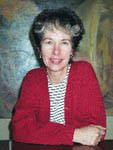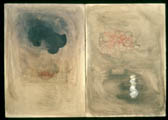crit streed 
cedar falls, iowa | interviewed 3-6-2002
biographical sketch | artist's statement | interview clips

"Requiescat in Pace"
painting
(click image for larger view)
copyright © 2001 Crit Streed | All Rights Reserved
interview clips (mp3 audio & text)
I had a full teaching day. I had visitors from Russia who were coming
in to give a little talk and a demonstration in my painting studio.
And I was trying to be upbeat and cordial, and I was simultaneously
thinking, Do they know about this? How should I approach them? They
didn't speak English, so everything was going through a translator.
I was trying to ask the translator if they were aware of what had
taken place. And yet at the same time, in this parallel kind of
moving forward, doing your practical day-to-day stuff, I was trying
to engage them in a discussion about art-making.
And we just simply went back and forth between routine and then
stopping and trying to comprehend.
I, in fact, had a show in New York that was coming up within the month.
So, from September 11th, I began to re-think, not consciously, what
I would be showing October 5th in New York. I had this other piece
that I'd been playing with in the studio. It was a piece that was
about a void. And suddenly I began to realize that it was exactly
how I was relating to this immense loss. It was a loss of physical
structure, it was a loss of lives, it was a loss of our understanding
of our culture. But that loss had a shape. So the piece that I eventually
took to New York, was called The Fragile Void. And it became
a metaphor for me, in reflection, that we essentially are the container
of all our memories, of all of our losses, of all the voids—of
something that was there, and is not there now. We contain that
void and we remember that void. And by giving shape to it, we have
the choice of what to do with that.
(see The
Fragile Void)
October 7 (Bombing of Afghanistan)
I was dreading it. I knew that that would happen. I had this awareness of this really horrendous life that the people in Afghanistan had been living, and at the same time, I knew that there was this dire circumstance that I was in support of trying to rectify, and that was of course the Taliban. I truly wish there was some way in which we could have handled that without going in with violence and force. I am thankful that the Taliban is no longer in power. Let's hope that the violence that we had to take, the strong stand, was for, in the end, a good purpose.
This was not a new piece. I think its life really began in relationship
to the events of September 11th. It was in my studio. I had for
some reason, drawn it out into the space as I was working on The
Fragile Void. The painting itself was about the very fragile
relationship of tenuous circumstances. What I wanted to do was to
really give my painting up, in a way, to those lost people, and
that's how the piece really came about.
The wonderful thing about art is that it becomes what it needs to become when you need it. That's really important, because the art that we create is a living thing. And it is very responsive, if you allow it to be, to the now, because that's how art continually lives. And it takes on the moment. That piece is special to me for its ability to do that.
Very importantly, I think what it has done for me is that it has heightened my awareness that I need to pay attention to how perceptions are formed, what other perspectives are. I also need to be aware that the world has changed from our point of view, but maybe it hasn't changed so much for other people's point of view in the world. So, there's a sense perhaps through this tragic event, that we are more closely aligned with the tragedies of other nations and other cultures—that we are in this small planet together.
I'm very thankful to be an American. We do have our interests, and our position in the world has been about securing those interests. But I think also we're a generous people, and I hope that we can continue to see the world as it is, and how fortunate we are, and to continue to be giving.
biographical sketch
Crit Streed was born in 1948 in Washington, Iowa, where she grew up. She has three older half-sisters, an older brother who has since died, and a younger brother.
She received a B.A. in art from the University of Northern Iowa, Cedar Falls, and her M.A. in painting and drawing and M.F.A. in painting and lithography from the University of Iowa, Iowa City.
Between short-term teaching positions, she lived and worked in Nepal from 1982 to 1984, and has done artist residencies elsewhere. She has exhibited widely and is represented by A.I.R. Gallery in New York City.
She is a professor of art at the University of Northern Iowa, where she has taught since the 1980s. In her own artwork, she paints, draws, does mixed media installations, and has done a lot of encaustic in the last several years. She lives in Cedar Falls with her husband and mother; her only child, a daughter, died at age six.
artist's statement
I stood in front of one of the fire stations in New York City that sent the first firefighters to the site at the World Trade Center on September 11th. The fire station had been turned into a shrine with flowers, posters, lighted candles interspersed with photos of lost men and women. Amidst these layers I found a quote from the Tibetan Book of the Dead. It asked for conscious assistance from the living for those who had lost their lives, so that the dead could make passage through the trauma of such a violent death. This painting is my offering…rest in peace.



